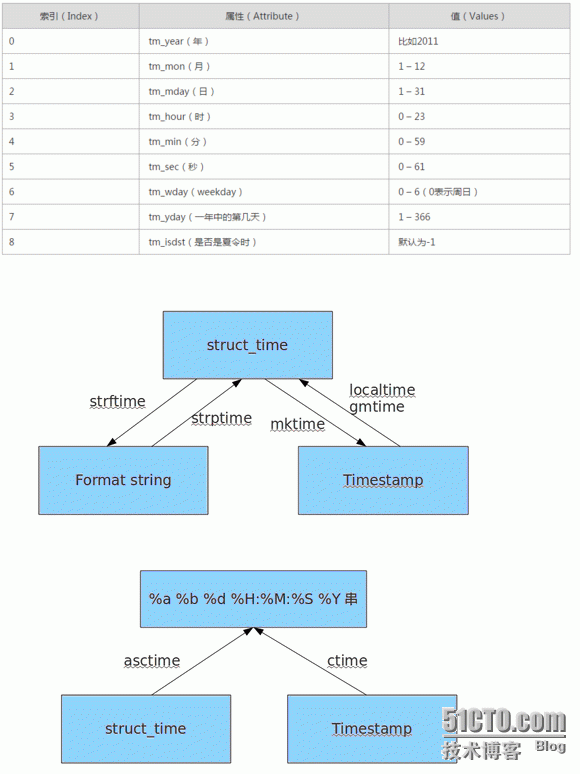九、time
時間相關的操作,時間有三種表示方式:
時間戳 1970年1月1日之後的秒,即:time.time()
格式化的字符串 2014-11-11 11:11, 即:time.strftime('%Y-%m-%d')
結構化時間 元組包含了:年、日、星期等... time.struct_time 即: time.localtime()
print time.time()
print time.mktime(time.localtime())
print time.gmtime() #可加時間戳參數
print time.localtime() #可加時間戳參數
print time.strptime('2014-11-11', '%Y-%m-%d')
print time.strftime('%Y-%m-%d') #默認當前時間
print time.strftime('%Y-%m-%d',time.localtime()) #默認當前時間
print time.asctime()
print time.asctime(time.localtime())
print time.ctime(time.time())
import datetime
'''
datetime.date:表示日期的類。常用的屬性有year, month, day
datetime.time:表示時間的類。常用的屬性有hour, minute, second, microsecond
datetime.datetime:表示日期時間
datetime.timedelta:表示時間間隔,即兩個時間點之間的長度
timedelta([days[, seconds[, microseconds[, milliseconds[, minutes[, hours[, weeks]]]]]]])
strftime("%Y-%m-%d")
'''
import datetime
print datetime.datetime.now()
print datetime.datetime.now() - datetime.timedelta(days=5)十、re
re模塊用於對python的正則表達式的操作。
字符:
. 匹配除換行符以外的任意字符
\w 匹配字母或數字或下劃線或漢字
\s 匹配任意的空白符
\d 匹配數字
\b 匹配單詞的開始或結束
^ 匹配字符串的開始
$ 匹配字符串的結束
次數:
* 重複零次或更多次
+ 重複一次或更多次
? 重複零次或一次
{n} 重複n次
{n,} 重複n次或更多次
{n,m} 重複n到m次
IP:
^(25[0-5]|2[0-4]\d|[0-1]?\d?\d)(\.(25[0-5]|2[0-4]\d|[0-1]?\d?\d)){3}$
手機號:
^1[3|4|5|8][0-9]\d{8}$1、match(pattern, string, flags=0)
從起始位置開始根據模型去字符串中匹配指定內容,匹配單個
正則表達式
要匹配的字符串
標誌位,用於控制正則表達式的匹配方式
import re
obj = re.match('\d+', '123uuasf')
if obj:
print obj.group()# flags I = IGNORECASE = sre_compile.SRE_FLAG_IGNORECASE # ignore case L = LOCALE = sre_compile.SRE_FLAG_LOCALE # assume current 8-bit locale U = UNICODE = sre_compile.SRE_FLAG_UNICODE # assume unicode locale M = MULTILINE = sre_compile.SRE_FLAG_MULTILINE # make anchors look for newline S = DOTALL = sre_compile.SRE_FLAG_DOTALL # make dot match newline X = VERBOSE = sre_compile.SRE_FLAG_VERBOSE # ignore whitespace and comments
2、search(pattern, string, flags=0)
根據模型去字符串中匹配指定內容,匹配單個
import re
obj = re.search('\d+', 'u123uu888asf')
if obj:
print obj.group()3、group和groups
a = "123abc456"
print re.search("([0-9]*)([a-z]*)([0-9]*)", a).group()
print re.search("([0-9]*)([a-z]*)([0-9]*)", a).group(0)
print re.search("([0-9]*)([a-z]*)([0-9]*)", a).group(1)
print re.search("([0-9]*)([a-z]*)([0-9]*)", a).group(2)
print re.search("([0-9]*)([a-z]*)([0-9]*)", a).groups()4、findall(pattern, string, flags=0)
上述兩中方式均用於匹配單值,即:只能匹配字符串中的一個,如果想要匹配到字符串中所有符合條件的元素,則需要使用 findall。
import re
obj = re.findall('\d+', 'fa123uu888asf')
print obj5、sub(pattern, repl, string, count=0, flags=0)
用於替換匹配的字符串
content = "123abc456"
new_content = re.sub('\d+', 'sb', content)
# new_content = re.sub('\d+', 'sb', content, 1)
print new_content相比於str.replace功能更加強大
6、split(pattern, string, maxsplit=0, flags=0)
根據指定匹配進行分組
content = "'1 - 2 * ((60-30+1*(9-2*5/3+7/3*99/4*2998+10*568/14))-(-4*3)/(16-3*2) )'"
new_content = re.split('\*', content)
# new_content = re.split('\*', content, 1)
print new_content
content = "'1 - 2 * ((60-30+1*(9-2*5/3+7/3*99/4*2998+10*568/14))-(-4*3)/(16-3*2) )'"
new_content = re.split('[\+\-\*\/]+', content)
# new_content = re.split('\*', content, 1)
print new_content
inpp = '1-2*((60-30 +(-40-5)*(9-2*5/3 + 7 /3*99/4*2998 +10 * 568/14 )) - (-4*3)/ (16-3*2))'
inpp = re.sub('\s*','',inpp)
new_content = re.split('\(([\+\-\*\/]?\d+[\+\-\*\/]?\d+){1}\)', inpp, 1)
print new_content十一、random
隨機數
mport random print random.random() print random.randint(1,2) print random.randrange(1,10)
隨機驗證碼實例:
import random checkcode = '' for i in range(4): current = random.randrange(0,4) if current != i: temp = chr(random.randint(65,90)) else: temp = random.randint(0,9) checkcode += str(temp) print checkcode

